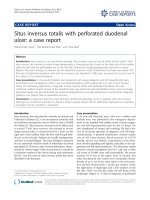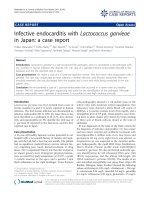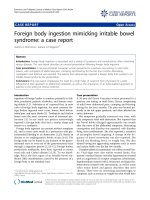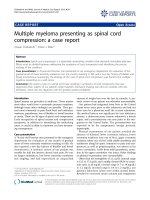Báo cáo y học: " Massive penoscrotal haematoma following inguinal hernia repair: a case report" docx
Bạn đang xem bản rút gọn của tài liệu. Xem và tải ngay bản đầy đủ của tài liệu tại đây (438.21 KB, 3 trang )
BioMed Central
Page 1 of 3
(page number not for citation purposes)
Journal of Medical Case Reports
Open Access
Case report
Massive penoscrotal haematoma following inguinal hernia repair: a
case report
Dharmendra K Shah
1
and Jayesh Sagar*
2
Address:
1
Department of Surgery, S.S.G. Hospital and Medical College, Vadodara, Gujarat, 390001, India and
2
Division of Surgery and
Interventional Science, Royal Free and University College Medical School, 9th Floor, Hampstead Campus, London, NW3 2QG, UK
Email: Dharmendra K Shah - ; Jayesh Sagar* -
* Corresponding author
Abstract
Introduction: Inguinal hernia is one of the commonest surgical conditions that one comes across
in a surgical career. Operative repair is the only successful treatment for hernias. As with other
surgical procedures, this is also associated with possible complications. Scrotal haematoma is one
of the well-known complications following hernia repair, but massive penoscrotal haematoma
requiring surgical intervention is very rare.
Case presentation: A 53-year-old black man had undergone elective hernia repair. He
underwent standard open hernia repair with a prolene mesh and developed massive scrotal
haematoma which required drainage. Eventually he recovered well, although slowly.
Conclusion: To achieve adequate bleeding control during and at the end of operation is the key
preventive measure to avoid scrotal haematoma. Here, we report a case of massive penoscrotal
haematoma following repair of a moderate sized inguinal hernia. We strongly emphasize the
importance of adequate control of bleeding, even in small to moderate sized inguinal hernias in
order to avoid such disastrous complications with long-term cosmetic disfigurement.
Introduction
Inguinal hernia is the commonest of all of the hernias.
Operative repair is the only acceptable method for treat-
ment of inguinal hernias where possible. This is consid-
ered the most common operation and the operative
procedure of choice for young training surgeons. As with
any other surgical condition, hernia repair is also associ-
ated with different possible complications such as infec-
tion, bleeding, recurrence, scrotal swelling and nerve
damage. These complications have been discussed in
detail in the English literature. Penoscrotal haematoma,
one of the complications, is a very well documented com-
plication following inguinal hernia repair, however, mas-
sive penoscrotal haematoma requiring surgical
intervention, is very rare and not yet reported in the Eng-
lish literature. Here, we present the case of a 53-year-old
black man who developed massive penoscrotal hae-
matoma following inguinal hernia repair that needed sur-
gical exploration. Following inguinal hernia repair, scrotal
haematoma or wound haematoma are treated conserva-
tively. In rare occasions, they may need wound explora-
tion or surgical drainage. Our patient developed a huge
penoscrotal haematoma that required surgical drainage of
the wound followed by drain placement. However, the
patient did not respond to surgical treatment of the hae-
matoma and had to undergo further drainage of the scro-
tal haematoma on the following day. As learned from this
case report, we strongly emphasize meticulous surgical
Published: 21 November 2008
Journal of Medical Case Reports 2008, 2:357 doi:10.1186/1752-1947-2-357
Received: 26 April 2008
Accepted: 21 November 2008
This article is available from: />© 2008 Shah and Sagar; licensee BioMed Central Ltd.
This is an Open Access article distributed under the terms of the Creative Commons Attribution License ( />),
which permits unrestricted use, distribution, and reproduction in any medium, provided the original work is properly cited.
Journal of Medical Case Reports 2008, 2:357 />Page 2 of 3
(page number not for citation purposes)
techniques to avoid and control bleeding during hernia
repair. We also point out the importance of close observa-
tion in the recovery period and in the ward following such
operations.
Case presentation
A 53-year-old black man had been admitted for elective
right inguinal hernia repair and excision of a lipoma from
his back at one of the private hospitals in London. He was
fit and healthy without any medical problems. He had
undergone open repair of a moderate-sized right inguinal
hernia with a prolene mesh and excision of the lipoma
from his back under general anaesthetic without any
intra-operative complications. After the two hour opera-
tion, he complained of pain at the operative site. Exami-
nation of the local area revealed a massive penoscrotal
haematoma. As he was stable haemodynamically, he
underwent wound exploration under general anaesthesia.
The bleeding spurts within the hernia wound were
stopped and the wound was closed with a Radivac drain.
A urethral catheter was inserted in the postoperative
period as he could not pass urine. He was started on oral
augmentin as prophylaxis. On the first postoperative day,
his haemoglobin dropped to 7.1 gm% so he was given 2
units of blood. The drain had released about 20 ml of
blood. On the second postoperative day, he was still in
pain. Local examination revealed a massive penoscrotal
haematoma (Figure 1) with no change in its size. He had
further drainage of the scrotal haematoma under local
anaesthesia and 200 ml of blood was evacuated. The
wound was closed with a corrugated drain. The patient
was investigated thoroughly by a haematologist and all
blood investigations including coagulation profile, Factor
XI bioassay, PFA-100 platelet function tests, vWF:antigen
assay and vWF:collagen binding were normal. The drain
was removed on the fourth postoperative day and the
patient was discharged on augmentin. On a follow-up
visit after 2 weeks, the patient was doing well without any
complaints although with cosmetic disfigurement.
Discussion
Inguinal hernia is one of the commonest surgical condi-
tions affecting especially the male population. Surgical
repair is the mainstay of treatment. As with any other sur-
gical procedure, this is associated with possible complica-
tions. These include urinary retention, superficial wound
haematoma, superficial wound infection, serous effusion,
scrotal oedema, recurrence of hernia, persistent inguinal
neuralgia, local hypoaesthesia, ischaemic orchitis and
penoscrotal haematoma [1]. Most of these complications
are of mild to moderate degree and can be treated by a
conservative approach. Recent advances in different surgi-
cal techniques and equipment claim to have less compli-
cations but none are completely devoid of them [2].
Penoscrotal haematoma is one of the most common com-
plications, and usually responds to a conservative
approach in the form of rest and scrotal support. In doubt-
ful cases, ultrasound evaluation of the penoscrotal hae-
matoma/swelling is a useful guide to confirm the
diagnosis [3] but in cases of massive haematoma, clinical
diagnosis is obvious and does not necessarily require
ultrasound. In cases of huge scrotal haematoma or unre-
solving haematoma, surgical drainage may be necessary.
Massive penoscrotal haematoma is not uncommon in
patients with bleeding disorders such as haemophilia
where trivial trauma can trigger severe bleeding in the
scrotum [4]. It has also been reported in patients follow-
ing transfemoral cardiac catheterization [5], percutaneous
transluminal angioplasty [6] and with rupture of the
Dacron aorto-femoral graft [7]. It has also been reported
as a complication following urological procedures [8,9].
Occurrence of penoscrotal haematoma following inguinal
hernia repair is well documented in the medical literature
but massive penoscrotal haematoma requiring surgical
intervention is very rare. Although we agree that surgeons
might have come across such complications more fre-
quently, especially in the developing countries, this is the
first time such a presentation has been reported in the
English literature. As occurred in our patient, occasionally,
such a massive haematoma may leave complications such
as cosmetic disfigurement and unsatisfactory sexual per-
formance. Usually scrotal haematoma following repair of
an inguinal hernia involves discoloration of the scrotum
and penis due to blood extravasation and haematoma of
the scrotum without haematoma of the penis. As in our
patient, the penile haematoma may be due to bleeding at
the superficial dartos plane (the plane between the super-
Massive penoscrotal haematoma following inguinal hernia repairFigure 1
Massive penoscrotal haematoma following inguinal
hernia repair. The drain is placed in the main wound fol-
lowing exploration of the right inguinal wound.
Publish with BioMed Central and every
scientist can read your work free of charge
"BioMed Central will be the most significant development for
disseminating the results of biomedical research in our lifetime."
Sir Paul Nurse, Cancer Research UK
Your research papers will be:
available free of charge to the entire biomedical community
peer reviewed and published immediately upon acceptance
cited in PubMed and archived on PubMed Central
yours — you keep the copyright
Submit your manuscript here:
/>BioMedcentral
Journal of Medical Case Reports 2008, 2:357 />Page 3 of 3
(page number not for citation purposes)
ficial dartos muscle of the scrotum and the dartos fascia of
the penis).
The purpose of presenting this case report is to emphasize
that meticulous and complete control of bleeding is
important during hernia repair to avoid such complica-
tions. We strongly recommend adequate control of bleed-
ing before closure of the wound in any kind of surgical
procedure. Different techniques have been employed in
practice such as the hitch-stitch and drain technique [10]
to prevent bleeding and avoid significant postoperative
haematoma. However, even simple techniques such as the
use of diathermy and/or suture ligation of blood vessels
along with meticulous surgical techniques may be helpful
to avoid bleeding. In our patient, we could not determine
why the surgeon failed to control bleeding before closure
of the wound. This rule of prevention rather than cure
does apply to all grades of surgeon, all grades of operation
and in all sectors of health care. We also advise thorough
investigations to rule out any bleeding tendency in
patients with massive inguino-scrotal hernia so as to
avoid any postoperative haematoma. This case also
focuses on the importance of close observation of the
patient by nursing staff in recovery as well as in the ward
in the immediate postoperative period. This case report
also raises a question over the possible use of a drain in
the inguinal hernia. Although the use of a drain following
repair of a large inguinal hernia is dubious and subjective,
we prefer to use a drain in huge inguinal hernia repair and
in doubtful haemostasis but we admit that our patient suf-
fered from only a moderate sized inguinal hernia. One
may argue that if we had used a drain in the first opera-
tion, we would have eliminated the need for a second
operative intervention in this patient.
Conclusion
We conclude that haemostasis is paramount in any surgi-
cal procedure irrespective of the nature of surgery. We also
conclude that drains should be used in huge inguinal and
inguino-scrotal hernias to avoid haematoma and scrotal
swelling.
Abbreviations
Factor XI: plasma thromboplastin antecedent; PFA: Plate-
let Function Analyzer; vWF: Von Willebrand Factor
Consent
Written informed consent was obtained from the patient
for publication of this case report and any accompanying
images. A copy of the written consent is available for
review by the Editor-in-Chief of this journal.
Competing interests
The authors declare that they have no competing interests.
Authors' contributions
JS was involved in the study concept and design, patient
care, review of the literature and supervision of the work
DKS contributed in the preparation of this manuscript
along with the literature review.
Acknowledgements
I would like to acknowledge my wife, Bethani Sagar for her substantial con-
tribution to this manuscript.
References
1. Forte A, D'Urso A, Gallinaro LS, Lo Storto G, Bosco MR, Vietri F, Bel-
trami V: [Complications of inguinal hernia repair]. G Chir 2002,
23:88-92.
2. Tanovic H, Mesihovic R, Muhovic S: Randomized trial of TEP
laparoscopic hernioplasty versus Bassni inguinal hernia
repair. Med Arh 2005, 59(4):214-216.
3. Archer A, Choyke PL, O'Brien W, Maxted WC, Grant EG: Scrotal
enlargement following inguinal herniorrhaphy: ultrasound
evaluation. Urol Radiol 1988, 9:249-252.
4. Ekeke ON, Nwauche CA: An uncommon cause of massive
penoscrotal haematoma. Niger J Med 2004, 13:64-66.
5. Borden TA, Rosen RT, Schwarz GR: Massive scrotal hematoma
developing after transfemoral cardiac catheterization. Am
Surg 1974, 40:193-194.
6. Shah J, Middleton S, Derodra J: Massive scrotal haematoma: a
complication of percutaneous transluminal angioplasty. Int J
Clin Pract 2001, 55:722.
7. Irace L, Stumpo R, Costa P, Trenti E, Bernucci P, Gallo P, Benedetti-
Valentini F: Rupture of Dacron aorto-femoral graft. Case
report. J Cardiovasc Surg (Torino) 1999, 40:879-881.
8. Ceylan K, Yuksel Y, Hasan G, Alpaslan K: Inguinal approach in
adult hydrocele surgery: preliminary randomized study. Adv
Ther 2006, 23:159-162.
9. Johal NS, Nitkunan T, O'Malley K, Cuckow PM: The two-stage
repair for severe primary hypospadias. Eur Urol 2006,
50:366-371.
10. Joseph MG, O'Boyle PJ: The 'hitch-stitch' and drain technique
for the prevention of inguinoscrotal haematoma following
complicated inguinoscrotal surgery. J R Coll Surg Edinb 1989,
34:104-105.









